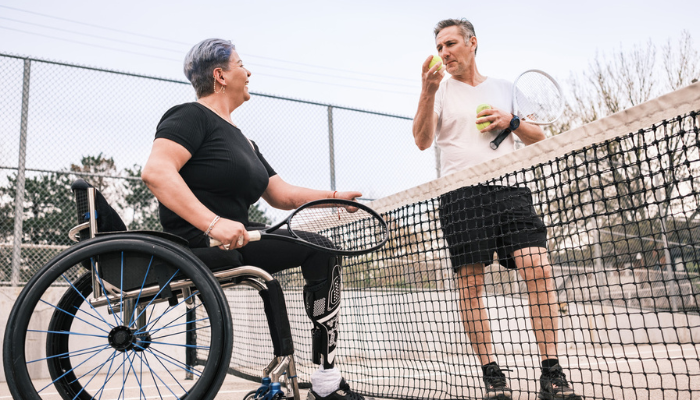
28 Dec Diversity in Sports through Disability Inclusion
The narrative of diversity in sports has undergone a profound transformation, expanding its scope to include athletes with disabilities. This paradigm shift challenges conventional perceptions and underscores the resilience, skill, and indomitable spirit of those who navigate the challenges of sports with disabilities. In this article, we’ll discuss the landscape of diversity in sports, with a focus on creating disability inclusion and the actionable steps we can take to promote it.
A Paradigm Shift in Athletic Excellence:
Traditionally, sports has been synonymous with physical prowess and athleticism. However, athletes with disabilities are redefining these standards, showcasing that excellence in sports transcends physical abilities. It’s a paradigm shift that encourages us to appreciate the diversity of talents and skills within the sports arena.
The Global Stage of Inclusivity: The Paralympic Movement:
One of the most powerful demonstrations of global commitment to inclusive sports is the Paralympic Games. Held alongside the Olympic Games, the Paralympics provide a platform for athletes with disabilities to compete at the highest level. This global platform not only applauds athletic accomplishments but also confronts widespread societal views on disability at a significant level.
Innovations Transforming the Playing Field:
Progress in adaptive equipment and technology has been instrumental in cultivating inclusivity within the realm of sports. Specialized wheelchairs, prosthetic limbs, and cutting-edge technologies empower athletes to participate in various sports, breaking down physical barriers and paving the way for an inclusive playing field.
The Impact of Representation:
The visibility of athletes with disabilities in mainstream sports media is crucial for challenging stereotypes and inspiring future generations. Showcasing their accomplishments and personal narratives enhances a sports culture that embraces inclusivity, cultivating respect and admiration for a variety of athletic abilities.
Grassroots Initiatives: From Local Programs to Global Change:
At the grassroots level, inclusive sports programs are creating opportunities for individuals with disabilities to participate in competitive and recreational activities. These initiatives not only promote physical health but also emphasize social integration, building a sense of community and teamwork.
Educational Empowerment: Breaking Down Barriers:
Educational initiatives and awareness campaigns play a crucial role in advancing diversity and fostering inclusion in sports. By educating coaches, athletes, and spectators about different disabilities and adaptive sports, these initiatives contribute to a more supportive and understanding sports culture.
Tackling Challenges, Celebrating Triumphs:
While the journey towards inclusivity in sports has made significant strides, challenges persist. Accessible facilities, equal opportunities, and overcoming societal misconceptions are areas that require attention. Athletes facing disabilities persist in conquering obstacles, transforming them into victories that inspire and pave the path for the generations to come.
Taking Action: Promoting Disability Inclusion in Sports:
Raise Awareness: Share stories of athletes with disabilities, emphasizing their achievements, and the challenges they’ve overcome. Harness the power of social media, blogs, and community events to amplify and magnify their voices.
Support Inclusive Programs: Advocate for and actively support inclusive sports programs in your community. Promote and inspire local schools, clubs, and organizations to create opportunities for individuals with disabilities to engage in sports.
Educate and Train: Provide educational resources and training for coaches, athletes, and sports administrators on disability awareness and inclusive practices. Cultivate a setting where everyone experiences a sense of belonging.
Celebrate Diversity in Sports Media: Promote inclusivity in sports media by featuring a variety of representations. Highlight athletes with disabilities in mainstream media coverage to enhance understanding and challenge existing stereotypes.
Accessible Facilities: Advocate for and support the development of accessible sports facilities. Guarantee that infrastructure is crafted to cater to individuals with a range of abilities.
Collaborate with Advocacy Groups: Collaborate with organizations advocating for disabilities to gain insights into the challenges faced by athletes with disabilities and actively participate in developing solutions.
In embracing diversity in sports through disability inclusion, we are not just breaking boundaries; we are reshaping the narrative of what it means to be an athlete. It’s a journey of empowerment, resilience, and collective action. Through implementing these tangible measures, we contribute to a world where every individual, irrespective of their abilities, can engage, compete, and excel in the realm of sports.


